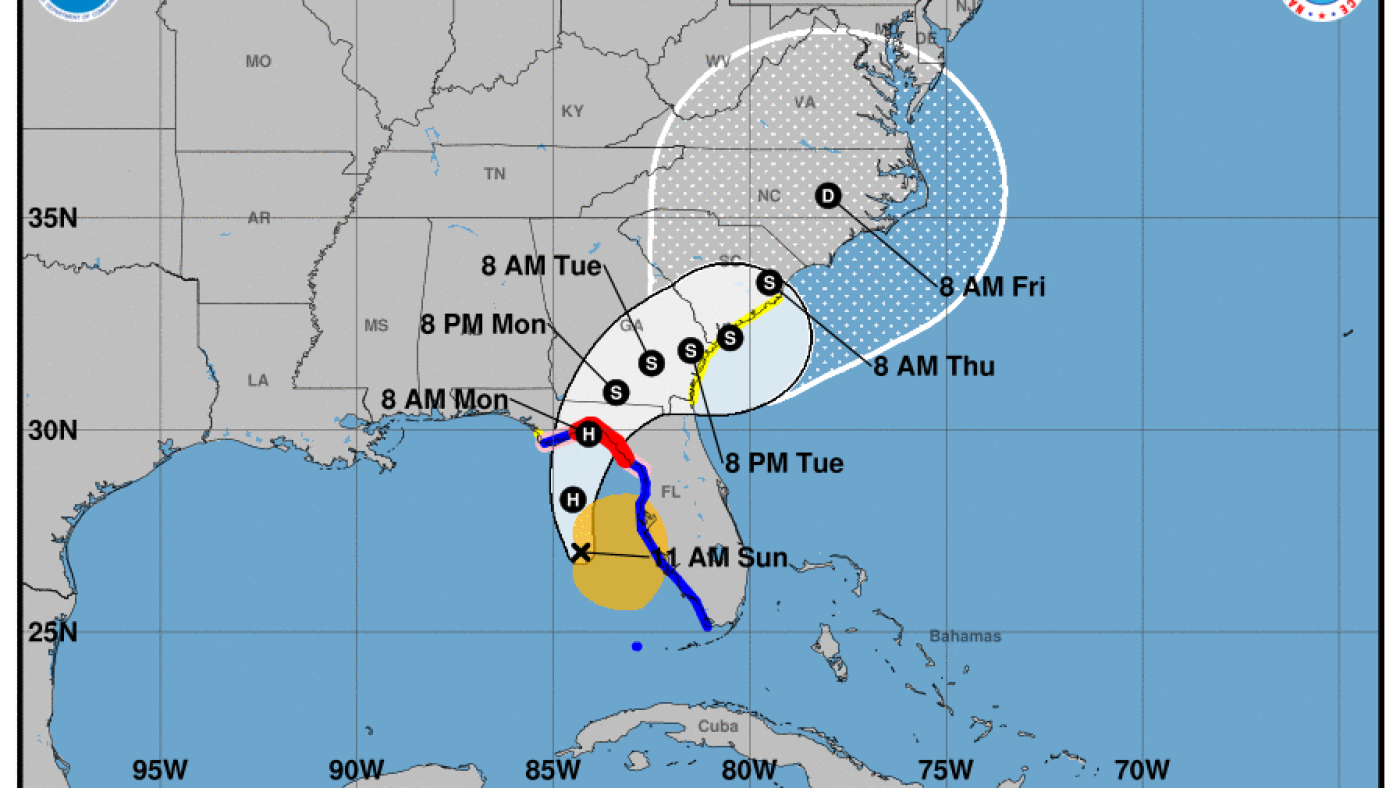A graphic shows the projected path of Tropical Storm Debby as it crosses Florida, Georgia and South Carolina.
National Weather Service
hide caption
toggle caption
National Weather Service
Forecasters expect Tropical Storm Debby, a major weather system churning in the Gulf of Mexico, to reach hurricane-strength over the weekend before making landfall in Florida Monday morning.
State officials and meteorologists are urging residents along Florida’s Big Bend coast and beyond to prepare for high winds, potentially severe flooding and unusually heavy rains.
“It’s going to be far beyond the center of the storm. So just prepare for that,” Florida Gov. Ron DeSantis said of the rainfall forecast during a Sunday morning press conference. “Just because you’re not in the eye of the storm, it does not mean you are not going to have major, major impacts from the storm.”
The National Hurricane Center says Debby could unleash catastrophic conditions in Florida as well as in parts of Georgia and South Carolina later in the week, dropping potentially record-breaking rainfall amounts in those two states.
“There are some really amazing rainfall totals being forecast — and amazing in a very bad way,” National Hurricane Center director Michael Brennan said during a Sunday briefing.
Florida could see six to 12 inches of rain, with isolated amounts as high as 18 inches, and coastal areas in Georgia and South Carolina could be hit even harder. Brennan said communities near Savannah and Charleston could see between 10 and 20 inches of widespread rainfall, with isolated totals as high as 30 inches in some areas.
“That would be record-breaking rainfall associated with a tropical cyclone for both the states of Georgia and South Carolina if we got up to the 30-inch level,” he noted.
Warmer ocean temperatures and higher sea levels driven by climate change are making hurricanes and tropical storms more intense, causing heavier rainfall and more extreme flooding.
As of Sunday morning, Debby was located about 130 miles west-southwest of Tampa with maximum sustained winds of around 65 miles per hour.
Storm surge warnings and watches as well as hurricane warnings and watches were in effect for parts of Florida’s Gulf Coast, particularly in the Tallahassee area and around the Big Bend. Forecasters said the storm surge could rise as high as six to 10 feet above ground level in communities between the Suwannee and Ochlockonee rivers. Some local mandatory and voluntary evacuations were in place.
Flash flooding was also in the forecast for parts of northern Florida, where DeSantis said the ground was already full of water in some places. “We already have saturation in those areas, so you are going to be at risk of flooding,” he said.
DeSantis issued an emergency declaration on Thursday ahead of the storm and readied search-and-rescue operations and other state resources to deal with the potential fallout from the severe weather. He told residents to expect power outages.
On Saturday, President Joe Biden approved Florida’s request for a federal emergency declaration ahead of Debby’s arrival, which authorizes the Federal Emergency Management Agency, or FEMA, to help coordinate disaster relief efforts.
After Debby makes landfall on Monday, forecasters expect the storm to slow to a crawl as it moves across Florida, Georgia and South Carolina over several days this week.
Brennan said the exact track the storm would take over land was still unclear, but forecasters were “very confident we’re going to have a slow-moving system that’s going to result in multiple days of very, very heavy rainfall.”
A storm surge watch was in effect on Sunday for parts of the Georgia and South Carolina coastlines from the St. Mary’s River in Georgia to the South Santee River in South Carolina.
Georgia Gov. Brian Kemp declared a state of emergency for the entire state, warning residents of the possibility of significant flooding.
Roughly the same area of Florida faced another major storm around this time last year, when Hurricane Idalia made landfall as a Category 3 hurricane on the state’s Gulf Coast in the waning days of August.
Idalia brought strong winds and heavy rains that caused widespread flooding across the region.
